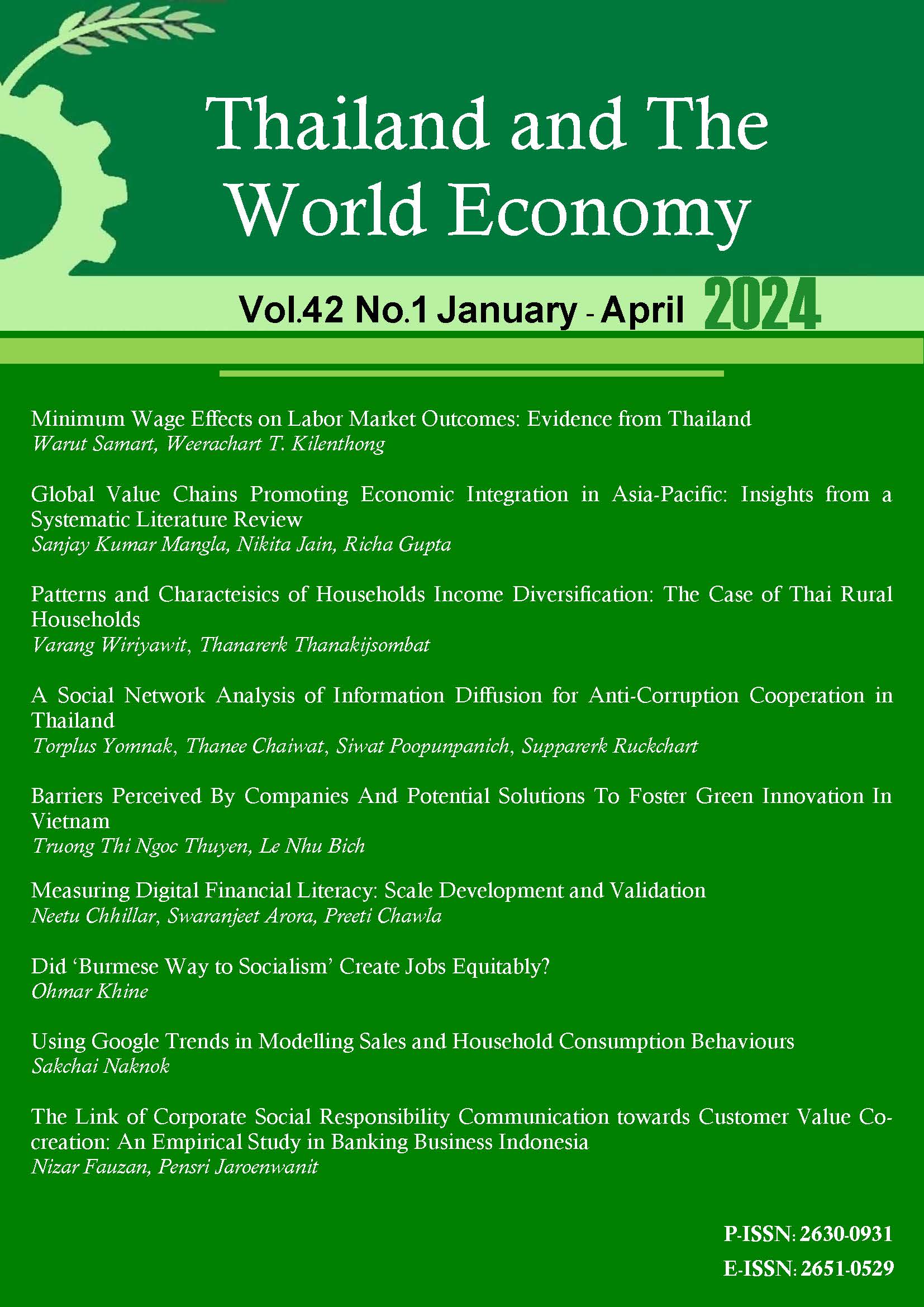A Social Network Analysis of Information Diffusion for Anti-Corruption Cooperation in Thailand
Keywords:
Corruption, Collaboration, Social Network AnalysisAbstract
Systematic and efficient collaboration are key contributing factors to efficiency in anti-corruption efforts. Research shows Thailand’s anti-corruption networks are decentralised. There are no formal central nodes responsible for coordinating between them. This makes the network not as efficient as it should be. Nevertheless, the work had its limitations. They only studied static relationships and analysed only missions. Thus, this study employs experimental networking to design surveys on information communication within networks, with social network analysis as a tool to analyse data and study dynamics of communication in the network. The results confirm the scattered communication pattern. The advantage is economies of scale in information distribution. However, such a pattern obstructs the efficient flow of information in the network. Information would flow slowly, leading to the risk of losing important information. This poses a significant challenge to collaboration in the network. Thus, Thailand’s anti-corruption networks should be structured systematically, with a focus on efficiency in information communication, based on the findings from this paper.
References
Abbasi, A., & Altmann, J. (2010). A social network system for analyzing publication activities of researchers. In T. J. Bastiaens, U. Baumöl, & B. J. Krämer (Eds.), On Collective Intelligence Advances in Intelligent and Soft Computing (76, pp. 49-61). Berlin, Heidelberg: Springer.
Anti-Corruption Organization of Thailand, (2016). Summary Report of Thailand’s Anti-Corruption Collaboration Workshop (Anti-Corruption Social Lab). (non-publication)
Battiston, S., & Catanzaro, M. (2004). Statistical properties of corporate board and director networks. The European Physical Journal B, 38(2), 345-352.
Bazerman, M., & Schoramn, F. (1983). A limited rationality model of interlocking directorates. Academy of Management and Review, 8(2), 206-217.
Borgatti, S. P., Mehra, A., Brass, D. J., & Labianca, G. (2009). Network analysis in the social sciences. Science, 323(5916), 892-895.
Hambrick, M. E. (2012). Six degrees of information: Using social network analysis to explore the spread of information within sport social networks. International Journal of Sport Communication, 5(1), 16-34.
Hocevar, S.P., Jansen, E., Thomas, G.F., (2011). Inter-Organizational Collaboration: Addressing the Challenge. Homeland Security Affairs (7), 10 Years After: The 9/11 Essays (September 2011). Retrieved from https://www.hsaj.org/articles/64.
Hoppe, B., & Reinelt, C. (2010). Social network analysis and the evaluation of leadership networks. The Leadership Quarterly, 21(4), 600-619.
Kangsanant, K., (2003). Organization Development and Capacity-Building of the Office of the National Counter Corruption Commission. Bangkok, Thailand: The National Anti-Corruption Commission.
Kim, K., Altmann, J., & Hwang, J. (2011). Measuring and analyzing the openness of the Web2. 0 service network for improving the innovation capacity of the Web2. 0 system through collective intelligence. In On Collective Intelligence (pp. 93-105). Springer Berlin Heidelberg.
Kim, K., Altmann, J., & Hwang, J. (2010). Measuring and analyzing the openness of the Web2.0 service network for improving the innovation capacity of the Web2.0 system through collective intelligence. In T. Bastiaens, U. Baumöl, & B. Krämer of On Collective Intelligence (pp. 93-105). Berlin, Heidelberg: Springer.
Lambiotte, R., Delvenne, J. C., & Barahona, M. (2008). Laplacian dynamics and multiscale modular structure in networks. arXiv preprint arXiv:0812.1770.
Newman, M. E. (2006). Modularity and community structure in networks. Proceedings of the National Academy of Sciences, 103(23), 8577-8582.
Office of the National Anti-Corruption Commission. (2016). NACC5-year Strategies (BE 2013-2017). Retrieved from https://www.nacc.go.th/category/2018083118464627/list
Brin, S. (1998). The PageRank citation ranking: bringing order to the web. Proceedings of ASIS, 1998, 98, 161-172.
Pantasane, A. (2007). A study of public-private-civil society partnership strategy in corruption prevention and suppression. Bangkok, Thailand: National Anti-Corruption Commission.
Phongpaichit, P., & Baker, C.J. (2002). Thailand, economy and politics. Oxford: Oxford University Press.
Pathmanand, U. (2001). Globalization and democratic development in Thailand: the new path of the military, private sector, and civil society. Contemporary Southeast Asia, 24-42.
Starkey, P., (1998). Networking for development. Rugby, UK: Practical Action Publishing
Sung, H. E., & Chu, D. (2009). Does participation in the global economy reduce political corruption? An empirical inquiry. In J. Winterdyk, P. Reichel, & H. Dammer (Eds.), Crime and Crime Policy Vol. 5: A guided reader to research in comparative criminology/criminal justice (pp. 235-260). Bochum, Germany: Brockmeyer Verlag.
Sumano, B,.Nikomborirak D. & Lertpatcharanon, N. (2015). A Study of non-governmental anti-corruption organizations in Thailand. Bangkok: Thailand Development Research Institute. Retrieved from https://dl.parliament.go.th/handle/20.500.13072/562674
Tansey, O. (2009). Process Tracing And Elite Interviewing: A Case For Non-Probability Sampling. Methoden der vergleichenden Politik-und Sozialwissenschaft: Neue entwicklungen und anwendungen, 481-496.
Yomnak, T. (2015). Corruption in Thailand: A Study of Corruption and Anti-Corruption Reforms in Thailand’s Construction Sector (PhD thesis). Cambridge, UK: University of Cambridge.
Yomnak, T. (2020). Research report on research collaboration and capacity building for anti-corruption network in Thailand. Bangkok, Thailand. Retrieved from https://digital.library.tu.ac.th/tu_dc/frontend/Info/item/dc:176172.
Yomnak, T. & Ruckchart, S. (2021). Collaboration Network of Thailand’s Anti-Corruption Organizations. Southeast Asian Journal of Economics, 9(1), 27-46.
Downloads
Published
How to Cite
Issue
Section
License
Copyright (c) 2024 Thailand and The World Economy

This work is licensed under a Creative Commons Attribution-NonCommercial-NoDerivatives 4.0 International License.










